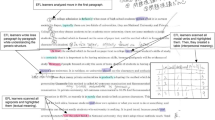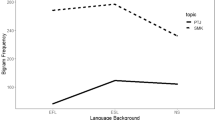Abstract
This study examined how students of English as a foreign language (EFL) with different first language (L1) backgrounds use interactional metadiscourse markers in argumentative writing. Specifically, to explore unique patterns of metadiscourse features that reflect context and development, the essays written by Chinese, Japanese, and Korean EFL students at three proficiency levels were analyzed for topic, L1 background, and L2 proficiency. For a comprehensive analysis of 1986 essays, I used a natural language processing tool that generates quantity scores for Hyland’s (2005) metadiscourse categories (i.e., hedges, boosters, attitude markers, self-mentions, reader pronouns, and directives). The results showed notable differences in the students’ use of metadiscourse features across topics, and significant variation was also found across different L1 groups. However, their use of interactional metadiscourse did not differ by L2 proficiency. A post hoc analysis of a parallel native-speaker corpus further revealed EFL students’ underuse of hedges and overuse of reader pronouns. Findings are discussed in terms of academic writing instruction, writing prompt development, and L2 learner categorization.
Similar content being viewed by others
Notes
Cohen’s d values indicate effect sizes for the comparison between two means. Cohen (1988) set d values of .2, .5, and .8 as benchmarks for small, medium, and large effects.
References
Abbuhl, R. (2006). Hedging and boosting in advanced-level L2 legal writing: The effect of instruction and feedback. In H. Byrnes, H. Weger-Guntharp, & K. A. Sprang (Eds.), Educating for advanced foreign language capacities: Constructs, curriculum, instruction, assessment (pp. 152–164). Washington, DC: Georgetown University Press.
Aull, L. (2019). Linguistic markers of stance and genre in upper-level student writing. Written Communication, 36, 267–295.
Aull, L. L., & Lancaster, Z. (2014). Linguistic markers of stance in early and advanced academic writing: A corpus-based comparison. Written Communication, 31, 151–183.
Bax, S., Nakatsuhara, F., & Waller, D. (2019). Researching L2 writers’ use of metadiscourse markers at intermediate and advanced levels. System, 83, 79–95.
Bloch, J., & Chi, L. (1995). A comparison of the use of citations in Chinese and English academic discourse. In D. Belcher & G. Braine (Eds.), Academic writing in a second language: Essays on research and pedagogy (pp. 231–274). Norwood: Ablex.
Bulté, B., & Housen, A. (2014). Conceptualizing and measuring short-term changes in L2 writing complexity. Journal of Second Language Writing, 26, 42–65.
Çandarlı, D., Bayyurt, Y., & Martı, L. (2015). Authorial presence in L1 and L2 novice academic writing: Cross-linguistic and cross-cultural perspectives. Journal of English for Academic Purposes, 20, 192–202.
Cheng, X., & Steffensen, M. S. (1996). Metadiscourse: A technique for improving student writing. Research in the Teaching of English, 30, 149–181.
Cheung, Y. L., & Low, T. H. (2019). Pre-university students’ voice construction in argumentative essays. RELC Journal, 50, 269–284.
Cohen, J. (1988). Statistical power analysis for the behavioral sciences (2nd ed.). Hillsdale: Lawrence Erlbaum.
Council of Europe. (2018). Common European framework of reference for languages: Learning, teaching and assessment. Cambridge: Cambridge University Press.
Crossley, S. A., & McNamara, D. S. (2014). Does writing development equal writing quality? A computational investigation of syntactic complexity in L2 learners. Journal of Second Language Writing, 26, 66–79.
Ferguson, C. J. (2009). An effect size primer: A guide for clinicians and researchers. Professional Psychology: Research and Practice, 40, 532–538.
Field, A. (2013). Discovering statistics using IBM SPSS statistics (4th ed.). London: SAGE.
Hall, J., & Navarro, N. (2011). Lessons for WAC/WID from language learning research: Multicompetence, register acquisition, and the college writing student. Across the Disciplines, 8, 1–16.
Hinds, J. (1990). Inductive, deductive, quasi-inductive: Expository writing in Japanese, Korean, Chinese, and Thai. In U. Connor & A. M. Johns (Eds.), Coherence in Writing: Research and pedagogical perspectives (pp. 89–109). Alexandria: Teachers to Speakers of Other Languages.
Hinkel, E. (2003). Adverbial markers and tone in L1 and L2 students’ writing. Journal of Pragmatics, 35, 1049–1068.
Hinkel, E. (2009). The effects of essay topics on modal verb uses in L1 and L2 academic writing. Journal of Pragmatics, 41, 667–683.
Ho, V., & Li, C. (2018). The use of metadiscourse and persuasion: An analysis of first year university students’ timed argumentative essays. Journal of English for Academic Purposes, 33, 53–68.
Holmes, J. (1982). Expressing doubt and certainty in English. RELC Journal, 13, 9–28.
Hong, H., & Cao, F. (2014). Interactional metadiscourse in young EFL learner writing: A corpus-based study. Interactional Journal of Corpus Linguistics, 19, 201–224.
Hu, M., & Liu, B. (2004). Mining and summarizing customer reviews. In Proceedings of the 10th ACM SIGKDD international conference on knowledge discovery and data mining (pp. 168–177).
Hudson, R. F., Lane, H. B., & Mercer, C. D. (2005). Writing prompts: The role of various priming conditions on the compositional fluency of developing writers. Reading and Writing: An Interdisciplinary Journal, 18, 473–495.
Huot, B. (1990). The literature of direct writing assessment: Major concerns and prevailing trends. Review of Educational Research, 60, 237–263.
Hyland, K. (2001). Bringing in the reader: Addressee features in academic articles. Written Communication, 18, 549–574.
Hyland, K. (2002a). Directives: Argument and engagement in academic writing. Applied Linguistics, 23, 215–239.
Hyland, K. (2002b). Authority and invisibility: Authorial identity in academic writing. Journal of Pragmatics, 34, 1091–1112.
Hyland, K. (2005). Stance and engagement: A model of interaction in academic discourse. Discourse Studies, 7, 173–192.
Hyland, K., & Milton, J. (1997). Qualification and certainty in L1 and L2 students’ writing. Journal of Second Language Writing, 6, 183–205.
Hyland, K., & Tse, P. (2004). Metadiscourse in academic writing: A reappraisal. Applied Linguistics, 25, 156–177.
Institute of International Education (IIE). (2019). Open doors 2019 fast facts. Retrieved from https://www.iie.org/Research-and-Insights/Open-Doors/Fact-Sheets-and-Infographics/Fast-Facts.
Intaraprawat, P., & Steffensen, M. S. (1995). The use of metadiscourse in good and poor ESL essays. Journal of Second Language Writing, 4, 253–272.
Ishikawa, S. (2013). The ICNALE and sophisticated contrastive interlanguage analysis of Asian learners of English. In S. Ishikawa (Ed.), Learner corpus studies in Asia and the world (pp. 91–118). Kobe: Kobe University.
Jarvis, S. (2000). Methodological rigor in the study of transfer: Identifying L1 influence in the interlanguage lexicon. Language Learning, 50, 245–309.
Klein, D., & Manning, C. D. (2003). Accurate unlexicalized parsing. In Proceedings of the 41st meeting of the association for computational linguistics (pp. 423–430).
Korbin, J. L., Deng, H., & Shaw, E. J. (2011). The association between SAT prompt characteristics, response features, and essay scores. Assessing Writing, 16, 154–169.
Lee, J. J., & Casal, J. E. (2014). Metadiscourse in results and discussion chapters: A cross-linguistic analysis of English and Spanish thesis writers in engineering. System, 46, 39–54.
Lee, J. J., & Deakin, L. (2016). Interactions in L1 and L2 undergraduate student writing: International metadiscourse in successful and less-successful argumentative essays. Journal of Second Language Writing, 33, 21–34.
Li, T., & Warton, S. (2012). Metadiscourse repertoire of L1 Mandarin undergraduates writing in English: A cross-contextual, cross-disciplinary study. Journal of English for Academic Purposes, 11, 345–356.
Maynard, S. (1993). Discourse modality: Subjectivity, emotion and voice in the Japanese language. Amsterdam: John Benjamins.
Mohammad, S., & Turney, P. (2013). Crowdsourcing a word-emotion association lexicon. Computational Intelligence, 29, 436–465.
Paek, H. (2005). Understanding celebrity endorsers in cross-cultural contexts: A content analysis of South Korean and US newspaper advertising. Asian Journal of Communication, 15, 133–153.
Plonsky, L., & Oswald, F. L. (2014). How big is “big”? Interpreting effect sizes in L2 research. Language Learning, 64, 878–912.
Qin, J., & Karabacak, E. (2010). The analysis of Toulmin elements in Chinese EFL university argumentative writing. System, 38, 444–456.
Reid, J. (1990). Responding to different topic types: A quantitative analysis from a contrastive rhetoric perspective. In B. Kroll (Ed.), Second language writing: Research insights for the classroom (pp. 191–210). New York: Cambridge University Press.
Römer, U. (2009). English in academia: Does nativeness matter? Anglistik: International Journal of English Studies, 20, 89–100.
Scollon, R., & Scollon, S. W. (2001). Intercultural communication (3rd ed.). Oxford: Blackwell.
Shen, F. (1989). The classroom and the wider culture: Identity as key to learning English composition. College Composition and Communication, 40, 456–466.
Williams, C. H. (2017). Teaching English in East Asia: A teacher’s guide to Chinese, Japanese, and Korean learners. Singapore: Springer.
Wolfe, C. R. (2011). Argumentation across the curriculum. Written Communication, 28, 193–219.
Yang, W., & Kim, Y. (2020). The effect of topic familiarity on the complexity, accuracy, and fluency of second language writing. Applied Linguistics Review, 11, 79–108.
Yang, W., Lu, X., & Weigle, S. C. (2015). Different topics, different discourse: Relationships among writing topic, measures of syntactic complexity, and judgments of writing quality. Journal of Second Language Writing, 28, 53–67.
Yoon, H. (2017a). Textual voice elements and voice strength in EFL argumentative writing. Assessing Writing, 32, 72–84.
Yoon, H. (2017b). Linguistic complexity in L2 writing revisited: Issues of topic, proficiency, and construct multidimensionality. System, 66, 130–141.
Yoon, H., & Römer, U. (2020). Quantifying disciplinary voices: An automated approach to interactional metadiscourse in successful student writing. Written Communication, 37, 208–244.
Zhao, C. G. (2017). Voice in timed L2 argumentative essay writing. Assessing Writing, 31, 73–83.
Zhou, A. A., Busch, M., & Cumming, A. (2014). Do adult ESL learners’ and their teachers’ goals for improving grammar in writing correspond? Language Awareness, 23, 234–254.
Author information
Authors and Affiliations
Corresponding author
Ethics declarations
Conflict of interest
The author declares that they have no conflict of interest.
Additional information
Publisher's Note
Springer Nature remains neutral with regard to jurisdictional claims in published maps and institutional affiliations.
Rights and permissions
About this article
Cite this article
Yoon, HJ. Interactions in EFL argumentative writing: effects of topic, L1 background, and L2 proficiency on interactional metadiscourse. Read Writ 34, 705–725 (2021). https://doi.org/10.1007/s11145-020-10085-7
Published:
Issue Date:
DOI: https://doi.org/10.1007/s11145-020-10085-7




